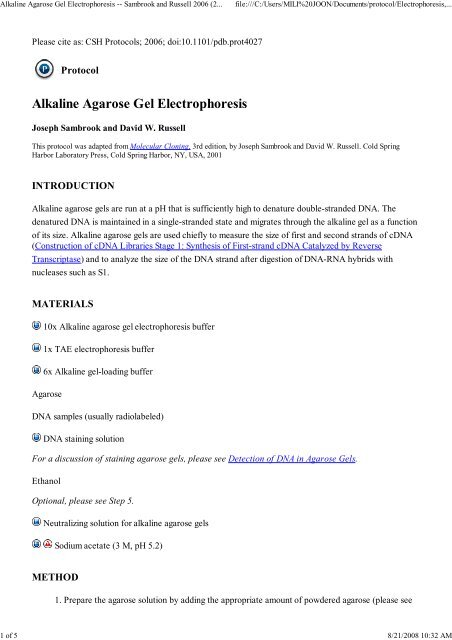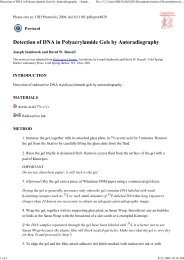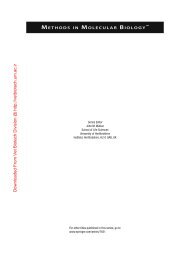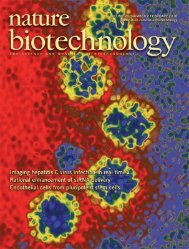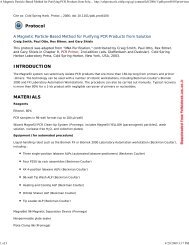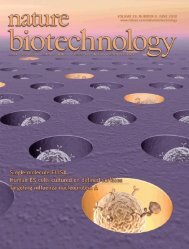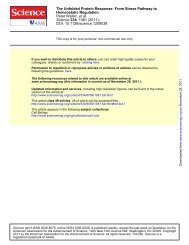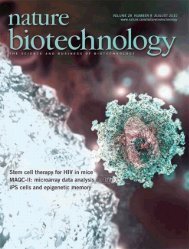Alkaline Agarose Gel Electr...
Alkaline Agarose Gel Electr...
Alkaline Agarose Gel Electr...
You also want an ePaper? Increase the reach of your titles
YUMPU automatically turns print PDFs into web optimized ePapers that Google loves.
<strong>Alkaline</strong> <strong>Agarose</strong> <strong>Gel</strong> <strong>Electr</strong>ophoresis -- Sambrook and Russell 2006 (2...<br />
file:///C:/Users/MILI%20JOON/Documents/protocol/<strong>Electr</strong>ophoresis,...<br />
1 of 5 8/21/2008 10:32 AM<br />
Please cite as: CSH Protocols; 2006; doi:10.1101/pdb.prot4027<br />
Protocol<br />
<strong>Alkaline</strong> <strong>Agarose</strong> <strong>Gel</strong> <strong>Electr</strong>ophoresis<br />
Joseph Sambrook and David W. Russell<br />
This protocol was adapted from Molecular Cloning, 3rd edition, by Joseph Sambrook and David W. Russell. Cold Spring<br />
Harbor Laboratory Press, Cold Spring Harbor, NY, USA, 2001<br />
INTRODUCTION<br />
<strong>Alkaline</strong> agarose gels are run at a pH that is sufficiently high to denature double-stranded DNA. The<br />
denatured DNA is maintained in a single-stranded state and migrates through the alkaline gel as a function<br />
of its size. <strong>Alkaline</strong> agarose gels are used chiefly to measure the size of first and second strands of cDNA<br />
(Construction of cDNA Libraries Stage 1: Synthesis of First-strand cDNA Catalyzed by Reverse<br />
Transcriptase) and to analyze the size of the DNA strand after digestion of DNA-RNA hybrids with<br />
nucleases such as S1.<br />
MATERIALS<br />
10x <strong>Alkaline</strong> agarose gel electrophoresis buffer<br />
1x TAE electrophoresis buffer<br />
6x <strong>Alkaline</strong> gel-loading buffer<br />
<strong>Agarose</strong><br />
DNA samples (usually radiolabeled)<br />
DNA staining solution<br />
For a discussion of staining agarose gels, please see Detection of DNA in <strong>Agarose</strong> <strong>Gel</strong>s.<br />
Ethanol<br />
Optional, please see Step 5.<br />
Neutralizing solution for alkaline agarose gels<br />
Sodium acetate (3 M, pH 5.2)<br />
METHOD<br />
1. Prepare the agarose solution by adding the appropriate amount of powdered agarose (please see
<strong>Alkaline</strong> <strong>Agarose</strong> <strong>Gel</strong> <strong>Electr</strong>ophoresis -- Sambrook and Russell 2006 (2...<br />
file:///C:/Users/MILI%20JOON/Documents/protocol/<strong>Electr</strong>ophoresis,...<br />
2 of 5 8/21/2008 10:32 AM<br />
<strong>Agarose</strong> <strong>Gel</strong> <strong>Electr</strong>ophoresis) to a measured quantity of H 2 O in an Erlenmeyer flask or a glass<br />
bottle.<br />
2. Loosely plug the neck of the Erlenmeyer flask with Kimwipes. When using a glass bottle, make<br />
sure that the cap is loose. Heat the slurry in a boiling-water bath or a microwave oven until the<br />
agarose dissolves.<br />
Heat the slurry for the minimum time required to allow all of the grains of agarose to dissolve.<br />
Check that the volume of the solution has not been decreased by evaporation during boiling;<br />
replenish with H 2 O if necessary.<br />
3. Cool the clear solution to 55'C. Add 0.1 volume of 10x alkaline agarose gel electrophoresis<br />
buffer, and immediately pour the gel as described in <strong>Agarose</strong> <strong>Gel</strong> <strong>Electr</strong>ophoresis. After the gel is<br />
completely set, mount it in the electrophoresis tank and add freshly made 1x alkaline electrophoresis<br />
buffer until the gel is just covered.<br />
Do not add ethidium bromide because the dye will not bind to DNA at high pH.<br />
The addition of NaOH to a hot agarose solution causes hydrolysis of the polysaccharide. For this<br />
reason, the agarose is first melted in H 2 O and then made alkaline by the addition of NaOH just<br />
before the gel is poured.<br />
4. Collect the DNA samples by standard precipitation with ethanol. Dissolve the damp precipitates<br />
of DNA in 10-20 µl of 1x gel buffer. Add 0.2 volume of 6x alkaline gel-loading buffer.<br />
It is important to chelate all Mg 2+ with EDTA before adjusting the electrophoresis samples to<br />
alkaline conditions. In solutions of high pH, Mg 2+ forms insoluble Mg(OH) 2 precipitates that<br />
entrap DNA.<br />
It is not strictly necessary to denature the DNA with base before electrophoresis. The exposure of<br />
the samples to the alkaline conditions in the gel is usually enough to render the DNA singlestranded.<br />
5. Load the DNA samples dissolved in 6x alkaline gel-loading buffer into the wells of the gel as<br />
described in <strong>Agarose</strong> <strong>Gel</strong> <strong>Electr</strong>ophoresis. Start the electrophoresis at
<strong>Alkaline</strong> <strong>Agarose</strong> <strong>Gel</strong> <strong>Electr</strong>ophoresis -- Sambrook and Russell 2006 (2...<br />
file:///C:/Users/MILI%20JOON/Documents/protocol/<strong>Electr</strong>ophoresis,...<br />
3 of 5 8/21/2008 10:32 AM<br />
DNA to an uncharged nitrocellulose or nylon membrane as described in Southern Blotting:<br />
Capillary Transfer of DNA to Membranes.<br />
Alternatively, transfer the DNA directly (without soaking the gel) from the alkaline agarose<br />
gel to a charged nylon membrane (please see Southern Blotting: Capillary Transfer of DNA<br />
to Membranes).<br />
Detect the target sequences in the immobilized DNA by hybridization to an appropriate<br />
labeled probe (please see Southern Hybridization of Radiolabeled Probes to Nucleic Acids<br />
Immobilized on Membranes).<br />
Staining<br />
Soak the gel in neutralizing solution for 45 minutes at room temperature.<br />
Stain the neutralized gel with 0.5 µg/ml ethidium bromide in 1x TAE or with SYBR Gold.<br />
A band of interest can be sliced from the gel and subsequently eluted by one of the<br />
procedures described in Recovery of DNA from <strong>Agarose</strong> <strong>Gel</strong>s: <strong>Electr</strong>ophoresis onto<br />
DEAE-cellulose Membranesor Recovery of DNA from <strong>Agarose</strong> and Polyacrylamide <strong>Gel</strong>s:<br />
<strong>Electr</strong>oelution into Dialysis Bags.<br />
REFERENCES<br />
1. McDonell, M.W., Simon, M.N., and Studier, F.W. 1977. Analysis of restriction fragments of T7 DNA<br />
and determination of molecular weights by electrophoresis in neutral and alkaline gels. J. Mol. Biol. 110:<br />
119–146.[Medline]<br />
Caution<br />
Sodium acetate (NaOAc)<br />
Sodium acetate (NaOAc), see Acetic acid<br />
Recipe<br />
<strong>Alkaline</strong> <strong>Gel</strong>-loading Buffer<br />
300 mM NaOH<br />
6 mM EDTA<br />
18% (w/v) Ficoll (Type 400, Pharmacia)<br />
0.15% (w/v) bromocresol green<br />
0.25% (w/v) xylene cyanol
<strong>Alkaline</strong> <strong>Agarose</strong> <strong>Gel</strong> <strong>Electr</strong>ophoresis -- Sambrook and Russell 2006 (2...<br />
file:///C:/Users/MILI%20JOON/Documents/protocol/<strong>Electr</strong>ophoresis,...<br />
4 of 5 8/21/2008 10:32 AM<br />
For a 6x buffer.<br />
Recipe<br />
<strong>Alkaline</strong> agarose gel electrophoresis buffer<br />
For 10x solution: Add 50 ml of 10 N NaOH and 20 ml of 0.5 M EDTA (pH 8.0) to 800 ml of H 2 O and<br />
then adjust the final volume to 1 liter. Dilute the 10x alkaline agarose gel electrophoresis buffer with H 2 O<br />
to generate a 1x working solution immediately before use. Use the same stock of 10x alkaline agarose gel<br />
electrophoresis buffer to prepare the alkaline agarose gel and the 1x working solution of alkaline<br />
electrophoresis buffer.<br />
Recipe<br />
DNA staining solution<br />
Ethidium bromide (10 mg/ml)<br />
Alternatively, SYBR Gold may be used.<br />
or SYBR Gold solution<br />
Recipe<br />
Neutralizing Solution for <strong>Alkaline</strong> <strong>Agarose</strong> <strong>Gel</strong>s<br />
1 M Tris-Cl (pH 7.6)<br />
1.5 M NaCl<br />
Recipe<br />
Sodium acetate<br />
To prepare a 3 M solution: Dissolve 408.3 g of sodium acetate•3H 2 O in 800 mL of H 2 O. Adjust the pH to<br />
5.2 with glacial acetic acid or to 7.0 with dilute acetic acid. Adjust the volume to 1 L with H 2 O. Dispense<br />
into aliquots and sterilize by autoclaving.
<strong>Alkaline</strong> <strong>Agarose</strong> <strong>Gel</strong> <strong>Electr</strong>ophoresis -- Sambrook and Russell 2006 (2...<br />
file:///C:/Users/MILI%20JOON/Documents/protocol/<strong>Electr</strong>ophoresis,...<br />
5 of 5 8/21/2008 10:32 AM<br />
Recipe<br />
TAE<br />
Prepare a 50X stock solution in 1 L of H 2 O:<br />
242 g of Tris base<br />
57.1 mL of glacial acetic acid<br />
100 mL of 0.5 M EDTA (pH 8.0)<br />
The 1X working solution is 40 mM Tris-acetate/1 mM EDTA.<br />
Copyright © 2006 by Cold Spring Harbor Laboratory Press. Online ISSN: 1559-6095 Terms of Service All<br />
rights reserved. Anyone using the procedures outlined in these protocols does so at their own risk. Cold<br />
Spring Harbor Laboratory makes no representations or warranties with respect to the material set forth in<br />
these protocols and has no liability in connection with their use. All materials used in these protocols, but<br />
not limited to those highlighted with the Warning icon, may be considered hazardous and should be used<br />
with caution. For a full listing of cautions, click here.<br />
All rights reserved. No part of these pages, either text or images, may be used for any reason other than<br />
personal use. Reproduction, modification, storage in a retrieval system or retransmission, in any form or<br />
by any means-electronic, mechanical, or otherwise-for reasons other than personal use is strictly<br />
prohibited without prior written permission.<br />
CiteULike Connotea Del.icio.us Digg Reddit Technorati What's this?


